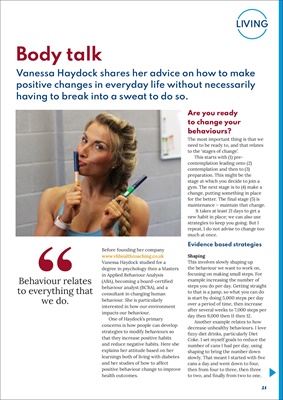
21
LIVING
Body talk
Vanessa Haydock shares her advice on how to make
positive changes in everyday life without necessarily
having to break into a sweat to do so.
Before founding her company
www.vhhealthcoaching.co.uk
Vanessa Haydock studied for a
degree in psychology then a Masters
in Applied Behaviour Analysis
(ABA), becoming a board-certified
behaviour analyst (BCBA), and a
consultant in changing human
behaviour. She is particularly
interested in how our environment
impacts our behaviour.
One of Haydock's primary
concerns is how people can develop
strategies to modify behaviours so
that they increase positive habits
and reduce negative habits. Here she
explains her attitude based on her
learnings both of living with diabetes
and her studies of how to affect
positive behaviour change to improve
health outcomes.
Behaviour relates
to everything that
we do.
Are you ready
to change your
behaviours?
The most important thing is that we
need to be ready to, and that relates
to the 'stages of change'.
This starts with (1) precontemplation
leading onto (2)
contemplation and then to (3)
preparation. This might be the
stage at which you decide to join a
gym. The next stage is to (4) make a
change, putting something in place
for the better. The final stage (5) is
maintenance - maintain that change.
It takes at least 21 days to get a
new habit in place; we can also use
strategies to keep you going. But I
repeat, I do not advise to change too
much at once.
Evidence based strategies
Shaping
This involves slowly shaping up
the behaviour we want to work on,
focusing on making small steps. For
example increasing the number of
steps you do per day. Getting straight
to that is a jump, so what you can do
is start by doing 5,000 steps per day
over a period of time, then increase
after several weeks to 7,000 steps per
day then 9,000 then 11 then 12.
Another example relates to how
decrease unhealthy behaviours. I love
fizzy diet drinks, particularly Diet
Coke. I set myself goals to reduce the
number of cans I had per day, using
shaping to bring the number down
slowly. That meant I started with five
cans a day and went down to four,
then from four to three, then three
to two, and finally from two to one.